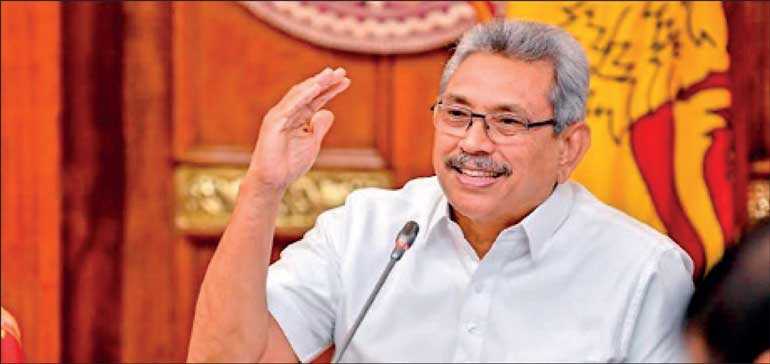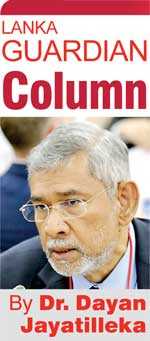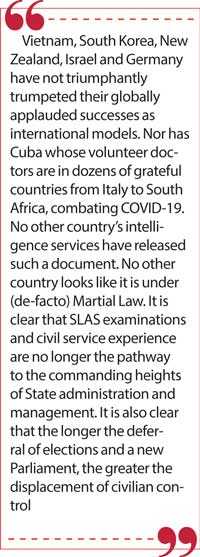Monday Apr 07, 2025
Monday Apr 07, 2025
Thursday, 14 May 2020 00:00 - - {{hitsCtrl.values.hits}}

President Gotabaya Rajapaksa faces an existential and strategic choice which will determine the direction, destination and destiny of the country and his presidency.
His constituency, the authoritarian-ultranationalist Sinhala Right, believes that its project is akin to those of Putin, Xi Jinping, Lee Kuan Yew and Mahathir Mohammed, comprising a mural of Eurasian modernity. On the other hand, it also believes that the Sinhala Buddhist, therefore Sinhala–and by extension Sri Lankan—ontology, hence destiny, is exceptional, unique and superior, with the military and the monks as repository pinnacles.
Secure within this self-centred cosmology, Sinhala ultra-nationalism doesn’t scientifically study, analyse, adapt and apply the paradigm of Eurasian/Asian modernity.
New mandarins, new myths
While Sri Lanka comes out comparatively ahead in South Asia–except for Kerala’s stellar achievement—and the WHO Sri Lanka observes that we are “on the right track towards containment”, the regime has already made international claims of success for Sri Lanka’s “unique” model of containment, defined by the Anti-COVID Task Force chief as “spearheaded by the Tri-Forces in collaboration with the health experts”. (http://www.sundaytimes.lk/200503/news/lankas-unique-response-to-battling-covid-19-in-the-spotlight-401428.html)
Furthermore, when a defensive battle is still raging nationally and globally, a rousing rendition of the Sri Lankan model is in the public domain as an 11-page document replete with colourful graphics, entitled ‘Combating COVID-19 Sri Lankan approach’ and “Researched and conceptualised by State Intelligence Service” rather than any recognised medical body. It concludes that “… It cascades from the vision of His Excellency the President…Sri Lankan model is an aggressive, strenuous and continuous process but comparison of data related to COVID-19 in the world suggests that Sri Lankan approach is a unique and dynamic model.” (http://www.dailymirror.lk/breaking_news/Covid-19-Sri-Lankan-approach/108-188021)
Vietnam, South Korea, New Zealand, Israel and Germany have not triumphantly trumpeted their globally applauded successes as international models. Nor has Cuba whose volunteer doctors are in dozens of grateful countries from Italy to South Africa, combating COVID-19.
No other country’s intelligence services have released such a document.
No other country looks like it is under (de-facto) Martial Law.
It is clear that SLAS examinations and civil service experience are no longer the pathway to the commanding heights of State administration and management. It is also clear that the longer the deferral of elections and a new Parliament, the greater the displacement of civilian control.
The public revulsion at parliamentarians and willingness to try out the military in a new role, is new to Sri Lanka and was not present even in 2015, but resulted from the performance of the last Parliament.
When I see a social media post with a photograph of a top commanding officer and Prime Minister Mahinda Rajapaksa side-by-side, which asks (in Sinhala) “Of These, Which One Do You Love?” and requests you to “react”, I know there’s a new social trend being manufactured and manipulated. It raises a sense of foreboding.
I was with my parents in Indonesia the month before the September 1965 coup (the atmosphere was captured in the movie ‘The Year of Living Dangerously’) after which 1½ million people died. My father had been invited by Sukarno’s Foreign Minister Dr. Subandrio. In 1968 we were in Greece after the Colonels Coup of ’67 and the BBC slipped word to its correspondent through my journalist father. In 1973 we were in Islamabad as guests of Prime Minister Zulfikar Ali Bhutto (later deposed by a coup), whom my father was friends with. In 2008 as ILO Chairman I worked closely with its D-G Juan Somavia, a close friend and renowned supporter of Chilean President Salvador Allende (bloodily overthrown by the junta). I can instinctively recognise the signs and trends.
Today’s choice is not between parties but between reviving a democratic impulse and taking a tyrannical turn.
The quibbling constitutionalists with their Procrustean perspective fail to grasp the primary danger of militarism and the crowding-out of civilian spaces—political, institutional, regulatory. The urgent imperative is an electoral opening for a functioning new legislature so as to outrun the encroachment of unipolar despotism and restore political accountability, systemic equilibrium and normality—or constitute a space for a countervailing discourse of resistance. Reconvening an old parliament for financial accountability and proroguing it, won’t do.
Putin paradigm
Bookending my year-and-a-half as Ambassador to Russia were two events which illustrate, as do many others in between, the fact that the ideology and morphology of the present Sri Lankan regime make it impossible to accommodate in the same category as the Putin leadership.
The Russian Foreign Ministry’s regular program for batches of incoming ambassadors, of briefings with nodal points of the state and government involving addresses by the relevant Ministers and top officials, kicked off in the case of our batch with a briefing on the Northern Caucuses. The Northern Caucuses encompasses Chechnya, Dagestan and the zone where a bitter, prolonged, intense separatist-terrorist war took place, ending with victory for the Russian state under the leadership of President Putin.
At the briefing there wasn’t a single mention of the war, terrorism, victory or the military. The Minister drew attention to the fact that our meeting was taking place in the Ministry housed in the same building where the Bolshevik Commissariat of the Nationalities was located and where the Commissar, Stalin, had resided. The entire focus of the briefing was the economic miracle in that area and the investment possibilities, due to the extensive political, economic and cultural autonomy granted the entire republic and regions and areas within it, democratically updating Stalin’s (not Lenin’s) model of territorial autonomy as the solution for ethno-nationalities questions. When I was about to leave Russia, my wife and I were invited to an event by a senior ambassador in Moscow, the ambassador of Mexico, who had arranged a talk by Dmitri Trenin, a top Russian intellectual personality, on his new book just out from Polity press, entitled “Russia”.
Trenin had a long career beginning in the 1970s as an officer of the Red Army and its successor, as well as a nuclear arms negotiator for Russia, and is now head of the Carnegie Foundation in Moscow acting as a bridge/backchannel between Russian and US policy intellectuals.
Introducing his book, he emphasised that “Unlike, say, Zhirinovsky, Putin was never a Russian hyper-nationalist, isn’t one now, and does not encourage Russian ultra-nationalism because he and his most serious advisors know it will spell the end of the Russian state. The Russian state, its preservation and strength, are his main concerns. Putin is a statist rather than a nationalist. He always stresses the multiethnic character of Russia’s society, acutely aware that 15% are Muslims. Read the texts of the peace accords with Chechnya and other trouble spots. A cornerstone of ‘Putinism’ is maximum self-rule and autonomy.”
Territorial autonomy is a structural feature of the model of Eurasian and Asian modernity, except in those rare societies that have no territorially-based ethnic communities (e.g. South Korea).
As the emotive though scaled-down 9 May celebrations of the 75th anniversary of humanity’s liberation from Hitler’s Nazi Fascism, in which 80% of Nazi casualties were on the Eastern front at the hands of the Soviet Red Army and only 20% on the Western front, demonstrate, the Russian military, the state and the citizenry are among the proudest in the world of their military achievements and perhaps the world’s foremost in their memorialisation. 
Except for Chechnya. While there are exhibits and memorial events for the veterans of the Afghan war, there are none for the Chechen wars. There is no wall of enforced silence. It is that the country as a whole has moved on from what was a bitter civil war, and the political and military elite have the strategic and historical good sense to know that lasting political reconciliation with Chechnya and the integration of the Islamic Chechens is far more crucial than rekindling memories of victory over separatist-terrorism. Muslim alienation is not risked.
The role of religion in relation to the state and politics is another important lesson that Russia holds out. The Russian Orthodox Church is very influential and respected, with the citizenry including the youth being devout. The clergy is well-educated and the ones such as Archbishop Hilarion and Fr. Alexei whom we were privileged to have conversations with, have doctoral degrees from Oxford. Putin is a believer but his religious observances are private and infrequently publicised. The top clergy is present on national occasions and social and state events, but not invited to preach or speak unless it is an explicitly religious occasion. They aren’t ensured a place more exalted than others. The Russian Orthodox Church is politically influential, but that influence is exercised selectively and strictly backstage.
Modern, rational, realist
To fight the pandemic, Putin indefinitely postponed the Duma (parliament) session which would have amended the Constitution to permit him to lead beyond 2024. Public welfare rather than personal political power took first priority.
Putin’s Russia sees itself as a fortress safeguarding the trinity of modernity, rationality and realism, opposed to the irrationality of both the post-modern decadence and pre-modern backwardness.
There is no progress without the revolution of modernity. Be it in the West or the East, the North or the South, a basic structural feature of modernisation is the liberation of the state, the political leadership, the government, and state policy, from domination by religion and the organised clergy. In Russia there is a civilisational, not political or policy interface, and the two spheres are largely separate except for tangential interaction.
When four members of the anarchist group Pussy Riot led by Nadezhda Tolokonnikova sprang a sacrilegious ‘punk prayer’ performance (with anti-Putin lyrics) at the altar of the famous Cathedral of Christ the Saviour in Moscow and were sentenced in 2012 to a women’s penal colony, they were amnestied in 2013 under a law pushed through strategically by Putin, who wanted the slate wiped clean of high-profile human rights cases in time for the Sochi Winter Olympics of 2014.
In the Eurasian model of modernity, be it in Russia, China, Vietnam, South Korea or Singapore, the state thinks as the state, and the strategic thinking of the state is secular; the perspective is not through an ethnoreligious prism. The strategic project of the Eurasian state—the zone that Henry Kissinger called ‘Eastphalia’, noting that it is that part of the planet which continue to adhere most closely to the Westphalian notion of state sovereignty—is national, regional, and global, not ethnoreligious or neo-tribalistic.
Even in Pakistan, however influential the mullahs are in society in some swathes, there is no visible nexus between them and the state, the political leadership and the military, or overt role in influencing policy at the highest levels as organised lobbies. I have yet to see mullahs given a role or place at any diplomatic function of a Pakistani Mission, such as the National Day.
Eurasian modernity is clear about the relationship between the military and the civilian political leadership. The universal norm from West to East and North to South is one of the supremacy of civilian political leadership. This is true in the Asian, Eurasian and Greater Eurasian spheres. The exceptions are Myanmar and (pre-Imran Khan) Pakistan, hardly models of Asian modernity.
China continues to base itself on Mao’s dictum that “the Party commands the gun and not the gun, the Party”. Though it is the PLA that built the temporary hospitals virtually overnight in Wuhan and other parts of China, the anti-COVID campaign is publicly led by Prime Minister Li Keqiang and his Deputy Prime Minister.
In Russia, the military and security/intelligence arms are crucially influential components of the power-bloc, and rightly so due to their superb quality and performance, but the political and foreign policy decisions come from the civilian power elite, and the respected Defence Minister, General Sergei Shoigu has a civilian background and political career trajectory.
The Russian military is not an instrument or the base of Putin’s domestic politics. The United Russia party is.
Israel pioneered through its domestic intelligence agency Shin Bet, the digital tracking of potential COVID-19 carriers by the use of anti-terrorist technology. The Israeli Supreme Court put a stop to that practice on the grounds that it would require parliamentary ratification. Obeying the courts and stopping the program did not prevent Israel from being one of the world’s top performers in countering the coronavirus.
Another relevant feature of the Asian/Eurasian model of modernity is the embrace (Lee Kuan Yew, Deng Xiaoping, Xi Jinping, etc.) of globalisation and economic opening, while striving for a more balanced, equitable, multipolar, multilateral and Asian-centric model of globalisation. Vietnam is an excellent example. The Sinhala New Right prefers splendid neo-isolationism.
Sri Lankan subjectivism
Vietnam’s General Vo Nguyen Giap wrote that “if you try to override the objective laws of development of a phenomenon, the objective laws will override you”.
Sri Lanka’s contending politico-ideological constellations do not think there are “objective” phenomena, laws or tendencies. They permanently inhabit the realm of subjectivity.
Take the LTTE. No other ‘liberation movement’ would have dared assassinate a frontline political leader of any country, still less one as powerful as India, and thought itself immune from consequence. No other armed non-state actor would have boycotted the April 2003 donor conference in Tokyo, but the Tigers did, with no decline in support from their constituency. No national minority would have rejected/avoided as did the Tamils, the chance to embed itself within and work a system of provincial autonomy, developing a strong economy, society and autonomous base. Sinn Fein proved it possible.
Take the JVP. No other movement would have murdered someone as nationally popular as Vijaya Kumaratunga and expected to succeed. The JVP resumed armed struggle full-on against the populist-nationalist Premadasa presidency which was exactly the sort that any radical left anywhere in the world would have either joined in government (they were promised three portfolios) or critically supported and propelled leftwards from outside. The JVP has never adopted the axiomatic feature of the united front of left parties, unlike in electorally successful leftwing administrations of Mexico, Nepal, Spain (and Kerala).
Take the UNP. Wickremesinghe officially affiliated the UNP with the International Democratic Union, the global fraternity of rightwing, centre-right, Conservative and Christian Democrat parties. An electoral strength of such parties is that they are patriotic-nationalist, harsh on terrorism and tough on security.
Ranil’s UNP kept losing elections precisely because its policy on terrorism, national security and sovereignty was far softer than most left-liberal parties the world over. Geneva 2015 would never have been co-sponsored by any other Conservative or rightwing governing party had it pertained to their country’s armed forces.
It is this subjectivist swerve from centrist realism that opened space for the triumph of the militarist Sinhala Right, its project dating back to N.Q. Dias and Richard Udugama in the 1960s. If the Sinhala New Right has its way, the country will not wind up achieving Asian/Eurasian modernity, but following and surpassing the Myanmar model. Myanmar however shares a border with China. We don’t.
Discover Kapruka, the leading online shopping platform in Sri Lanka, where you can conveniently send Gifts and Flowers to your loved ones for any event including Valentine ’s Day. Explore a wide range of popular Shopping Categories on Kapruka, including Toys, Groceries, Electronics, Birthday Cakes, Fruits, Chocolates, Flower Bouquets, Clothing, Watches, Lingerie, Gift Sets and Jewellery. Also if you’re interested in selling with Kapruka, Partner Central by Kapruka is the best solution to start with. Moreover, through Kapruka Global Shop, you can also enjoy the convenience of purchasing products from renowned platforms like Amazon and eBay and have them delivered to Sri Lanka.
Discover Kapruka, the leading online shopping platform in Sri Lanka, where you can conveniently send Gifts and Flowers to your loved ones for any event including Valentine ’s Day. Explore a wide range of popular Shopping Categories on Kapruka, including Toys, Groceries, Electronics, Birthday Cakes, Fruits, Chocolates, Flower Bouquets, Clothing, Watches, Lingerie, Gift Sets and Jewellery. Also if you’re interested in selling with Kapruka, Partner Central by Kapruka is the best solution to start with. Moreover, through Kapruka Global Shop, you can also enjoy the convenience of purchasing products from renowned platforms like Amazon and eBay and have them delivered to Sri Lanka.